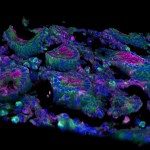Link to Pubmed [PMID] – 11435589
J Virol 2001 Aug; 75(15): 7086-96
Mandrillus sphinx, a large primate living in Cameroon and Gabon and belonging to the Papionini tribe, was reported to be infected by a simian immunodeficiency virus (SIV) (SIVmndGB1) as early as 1988. Here, we have identified a second, highly divergent SIVmnd (designated SIVmnd-2). Genomic organization differs between the two viral types; SIVmnd-2 has the additional vpx gene, like other SIVs naturally infecting the Papionini tribe (SIVsm and SIVrcm) and in contrast to the other SIVmnd type (here designated SIVmnd-1), which is more closely related to SIVs infecting l’hoest (Cercopithecus lhoesti lhoesti) and sun-tailed (Cercopithecus lhoesti solatus) monkeys. Importantly, our epidemiological studies indicate a high prevalence of both types of SIVmnd; all 10 sexually mature wild-living monkeys and 3 out of 17 wild-born juveniles tested were infected. The geographic distribution of SIVmnd seems to be distinct for the two types: SIVmnd-1 viruses were exclusively identified in mandrills from central and southern Gabon, whereas SIVmnd-2 viruses were identified in monkeys from northern and western Gabon, as well as in Cameroon. SIVmnd-2 full-length sequence analysis, together with analysis of partial sequences from SIVmnd-1 and SIVmnd-2 from wild-born or wild-living mandrills, shows that the gag and pol regions of SIVmnd-2 are closest to those of SIVrcm, isolated from red-capped mangabeys (Cercocebus torquatus), while the env gene is closest to that of SIVmnd-1. pol and env sequence analyses of SIV from a related Papionini species, the drill (Mandrillus leucophaeus), shows a closer relationship of SIVdrl to SIVmnd-2 than to SIVmnd-1. Epidemiological surveys of human immunodeficiency virus revealed a case in Cameroon of a human infected by a virus serologically related to SIVmnd, raising the possibility that mandrills represent a viral reservoir for humans similar to sooty mangabeys in Western Africa and chimpanzees in Central Africa.

